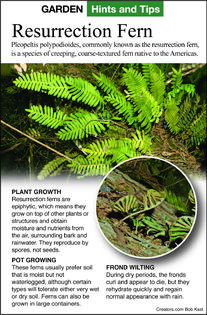The Greener View: Resurrection Plants
This is the Easter season, during which we celebrate Jesus' resurrection on Easter Sunday. So, I thought we could look at some plants that have the word resurrection in their name. There is a fern native to the U.S. commonly called the resurrection fern; a spike moss from the Chihuahuan desert is commonly called the resurrection plant; and there is a lily sometimes called the resurrection lily. I am going to take them in reverse order.
The lily is also called the surprise lily, magic lily and the naked lady lily, among other names. You may not want to have "naked lady" in your search history, so botanists call it Lycoris squamigera. It is in the amaryllis family. In the spring, it has leaves that look like daffodil leaves. The leaves die after a couple of months, and then in August, pink flower stalks shoot up out of the ground with clusters of pink flowers. It blooms nakedly because there are no leaves when there are flowers.
The resurrection plant, Selaginella lepidophylla, is also called the rose of Jericho, dinosaur plant and more. It looks like a fern, but it is not. It is a spike moss from the Chihuahuan desert of the United States and Mexico. During the rainy season, it looks like a flat fern, but during the dry season, it curls up into a dried-out ball. It is often sold as a novelty like a toy. Put it in water and in a few hours, it uncurls and might turn green. Take it out of the water and in a few hours, it curls up and turns brown. Each time it is watered, it grows. It needs to stay watered and green for a few weeks before watering is stopped and it curls up and turns brown. Each cycle of wet and dry consumes energy and nutrients. If the plant dries out too soon after opening, it won't photosynthesize long enough to make more sugar and will eventually die. If treated properly, it can lose up to 95% of its moisture and survive in the dry state for a couple of years.
Since it will open and close even when it is dead -- like a dry sponge expanding when it gets wet -- the plant you buy may already be dead. Advertising for this plant may describe it as blooming when it opens. It is a moss, so it doesn't have flowers. Some advertisements describe the plant as being 2 inches across and call it a jumbo. You really want to get one that is advertised as being at least 4 inches across when dry.
The resurrection fern is native from Maryland west to the southern tip of Illinois and then south to Central and South America, the Caribbean and even to Africa. For many years in virtually every advertisement for this plant, you would see the botanical name of Pleopeltis polypodioides. However, botanists have decided to split this plant into seven different species. The P. polypodioides species is now confined to cCentral and South America. The resurrection fern of the Southeast U.S., Mexico and Guatemala is P. michauxiana. Even though these ferns grow in many areas, you are most likely to find them in Florida, where they are very common.
This fern is an evergreen epiphyte. It grows on tree trunks, branches, fallen logs and an occasional rock. Epiphytes grow on other plants without taking nutrients from the host and without harming them.
During dry spells, the fronds on this fern curl up and dry out. Unlike the resurrection plant that grows in a desert, these ferns grow in a rainier and more humid climate. They usually don't have very long dry spells, but they can stay dormant for months at a time if necessary. They attach to the host plant through rhizomes that spread and often form a mat on the branches. The roots are mostly for attachment and don't absorb much water.
Just like the resurrection plant, the ferns will die if repeatedly forced into wet and dry cycles without enough time for the fern to photosynthesize and replace the sugars and nutrients necessary for survival.
For more information on all three of these resurrection plants and to see time lapse videos of them growing, check out the Greener View YouTube channel. I will be posting this video at 8 a.m. on Good Friday, which is April 18.
========
Email questions to Jeff Rugg at info@greenerview.com. To find out more about Jeff Rugg and read features by other Creators Syndicate writers and cartoonists, visit the Creators Syndicate website at www.creators.com.
Copyright 2025 Jeff Rugg. Distributed By Creators.








Comments